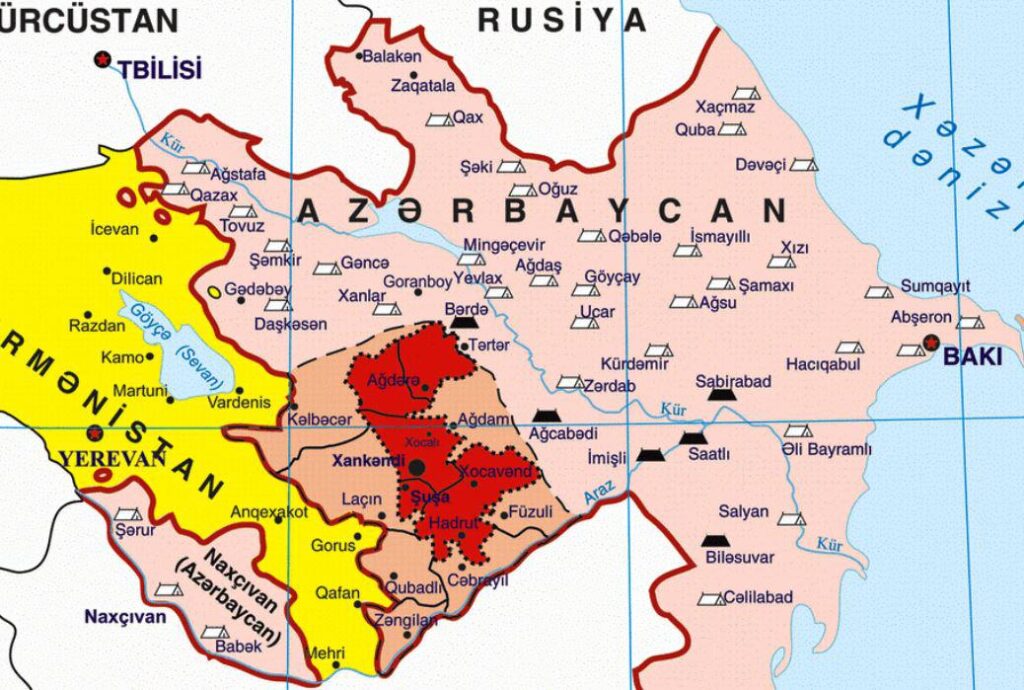The Azerbaijan and Armenia conflict -Nagorno-Karabakh started with the Armenians` open territorial claims to Azerbaijan`s historical lands and ethnic provocations in 1988. In the early 1980s, the Armenians in the Soviet Union leadership, leaders of Armenian SSR, and the Armenian diaspora abroad exploited the weakening of the central government of the USSR to embark on a campaign to annex the Nagorno-Karabakh Autonomous Oblast to Armenia.
One of Azerbaijan`s ancient settlement and culture centers, Nagorno-Karabakh is part of the Karabakh region. In 1923, the Soviet government established the Nagorno-Karabakh Autonomous Oblast (NKAO), covering a total area of 4,400 км², in the mountainous part of Karabakh. This laid the foundation of separatist trends in that region. But in fact, the root cause of the problem goes back to the 18th century when the Armenians, who were resettled in Azerbaijan, laid claims to Azerbaijani lands.
From 1987 to 1989, more than 250,000 Azerbaijanis were expelled from their historical lands in Armenia, with 216 of them brutally murdered, and 1,154 wounded.
At the February 20, 1988 session of the NKAO Soviet of People’s Deputies, members of the region`s Armenian community adopted a resolution to appeal to the Supreme Soviets of Azerbaijan SSR and Armenian SSR to annex NKAO to Armenian SSR.
On February 22, 1988, the Armenians opened fire on a peaceful demonstration staged by the Azerbaijanis near the town of Asgaran to protest against the decision of the Soviet of People’s Deputies of NKAO. Two Azerbaijani young people were killed in this incident to become the first victims of the conflict.
On December 1, 1989, the Supreme Soviet of Armenian SSR adopted an unprecedented resolution “On the unification of Armenian SSR and Nagorno-Karabakh”.
On January 10, 1990, the Presidium of the USSR Supreme Soviet adopted a resolution “On the nonconformity with the USSR Constitution of the acts on Nagorno-Karabakh adopted by Armenian SSR Supreme Soviet on December 1, 1989, and January 9, 1990”. The resolution described as illegal Armenian SSR`s act on the unification of Armenian SSR and Nagorno-Karabakh without Azerbaijan SSR`s consent.
On August 30, 1991, the Supreme Soviet of Azerbaijan declared the restoration of state independence. On October 18, the Constitutional Act “On the State Independence of the Republic of Azerbaijan” was adopted.
On November 26, 1991, the Supreme Soviet of the Republic of Azerbaijan adopted the Law ‘On the abolition of the Nagorno-Karabakh Autonomous Oblast of the Republic of Azerbaijan”.
In the late 1991-early 1992, the conflict entered its military stage. Having exploited the collapse of the Soviet Union and political instability in Azerbaijan caused by the internal standoff, Armenia began military operations in Nagorno-Karabakh with external military support.
In February of 1992, an unprecedented massacre of the Azerbaijani population of the town of Khojaly was committed. Known as the Khojaly Genocide, this tragedy resulted in thousands of Azerbaijanis being massacred or captured, and the town razed to the ground.
In May 1992, the town of Shusha and Lachin district, located between Armenia and Nagorno-Karabakh, were occupied. In 1993, the Armenian armed forces captured six more Azerbaijani districts around Nagorno-Karabakh – Kalbajar, Aghdam, Fuzuli, Jabrayil, Gubadli, and Zangilan.
On April 30, 1993, the UN Security Council adopted Resolution 822, demanding immediate withdrawal of all occupying forces from the Kalbajar district and other occupied areas of Azerbaijan.
On July 29, 1993, the UN Security Council adopted Resolution 853, demanding immediate complete, and unconditional withdrawal of the occupying forces from the district of Aghdam and all other occupied areas of the Republic of Azerbaijan.
On October 14, 1993, the UN Security Council adopted Resolution 874, calling for the immediate implementation of the reciprocal and urgent steps provided for in the CSCE Minsk Group’s “Adjusted timetable”, including the withdrawal of forces from recently occupied territories.
On November 11, 1993, the UN Security Council adopted Resolution 884, condemning the recent violations of the cease-fire established between the parties, which resulted in a resumption of hostilities, and particularly condemning the occupation of Zangilan district and the city of Horadiz, attacks on civilians and bombardments of the territory of the Republic of Azerbaijan, and demanding the unilateral withdrawal of occupying forces from Zangilan district and the city of Horadiz and the withdrawal of occupying forces from other recently occupied areas of the Republic of Azerbaijan.
Armenia`s military aggression resulted in the occupation by the Armenian armed forces of 20 percent of the territory of the Republic of Azerbaijan – Nagorno-Karabakh region and seven adjacent districts, including the town of Khankandi, the districts of Khojaly, Shusha, Lachin, Khojavand, Kalbajar, Aghdam, Fuzuli, Jabrayil, Gubadli, and Zangilan, as well as 13 villages in Tartar district, 7 villages in Gazakh district and 1 village in Sadarak district in Nakhchivan.
During the Armenia-Azerbaijan Nagorno-Karabakh conflict, more than one million Azerbaijanis became IDPs, while 20,000 people were killed in military operations and 50,000 were wounded and became disabled.
As an outcome of the conflict, 4,000 Azerbaijanis went missing, including 67 children, 265 women, and 326 elderly people. The fate of those people still remains unknown. More than 2,000 Azerbaijanis were captured and taken hostage by the Armenians. From 1988 to 1993, 900 settlements, 150,000 houses, 7,000 public buildings, 693 schools, 855 kindergartens, 695 health centers and hospitals, 927 libraries, 44 temples, 9 mosques, 473 historical monuments, palaces and museums, 40,000 museum exhibits, 6,000 industrial and agricultural enterprises, 160 bridges and other infrastructure facilities were destroyed in Karabakh.
Monuments representing world importance, which are located in Azerbaijan`s occupied lands, include medieval Khudafarin bridges with 11 and 15 spans and Niftali kurgans of the Bronze Age in Jabrayil, medieval Ganjasar and Khudavang monasteries in Kalbajar, 14th-century Gutlu Musa oglu mausoleum, and Uzerliktepe residential settlement of the Bronze Age in Aghdam, Azykh and Taghlar cave of the Paleolithic in Khojavand, and the Bronze and Iron age kurgans in Khojaly.
The mediation process for the Armenia-Azerbaijan Nagorno-Karabakh conflict was launched as part of the Conference on Security and Co-operation in Europe (CSCE) in February 1992. On March 24, 1992, the Committee of Senior Officials convened the Additional Meeting of the CSCE Council in Helsinki where the Council decided to convene a special conference in Minsk that would act as a permanent framework for negotiations to find a soonest possible peaceful solution to the conflict in accordance with the CSCE principals, commitments and provisions.
On May 12, 1994, a ceasefire agreement was reached. At the CSCE Budapest Summit on December 5-6, 1994, Heads of State and Government of the CSCE participating States set up the institution of the Co-Chairmanship of the Minsk Conference in order to coordinate all mediation efforts within the CSCE framework. The Budapest Summit tasked the CSCE Chairman-in-Office to conduct negotiations aimed at concluding a political agreement on the cessation of the armed conflict, the implementation of which would eliminate the consequences of the conflict and allow the convening of the Minsk Conference.
On March 23, 1995, the OSCE Chairman-in-Office issued a mandate for the Co-Chairs of the Minsk Process. At the OSCE Lisbon Summit, which was held on 2-3 December 1996, the Co-Chairs of the OSCE Minsk Group and the OSCE Chairman-in-Office recommended the principles, which should be the basis for the settlement of the Nagorno-Karabakh conflict. But Armenia did not accept these principles and was the only one out of 54 OSCE participating States not to support them.
Azerbaijan hopes that the world community will take more resolute and continuous steps to ensure a fair settlement of the Armenia-Azerbaijan conflict that will pave the way for the establishment of the environment of peace, security, and cooperation in the region and to press Armenia into starting work on a final peace deal that implies a final settlement of the conflict based on the main principles proposed by the OSCE Mink Group co-chair countries, which are influential members of the international community.
Many international organizations have adopted numerous documents on the settlement of the conflict in accordance with the principle of Azerbaijan`s territorial integrity.
The UN General Assembly Resolution of March 14, 2008, covered legal, political, and humanitarian aspects of the conflict and reaffirmed the principles of its settlement. These principles reaffirmed Azerbaijan’s territorial integrity, expressing support for the country’s internationally recognized borders and demanding the immediate withdrawal of all Armenian forces from all occupied territories, reaffirmed the inalienable right of the Azerbaijani population to return to their homes, and reaffirmed that no state should recognize as lawful the situation resulting from the occupation of Azerbaijan’s territories, or render assistance in maintaining that situation. The resolution also recognized the need to provide secure and equal conditions of life for Armenian and Azerbaijani communities in the Nagorno-Karabakh region, which would allow an effective democratic system of self-governance to be built up in the region within Azerbaijan.
The conflict has repeatedly been discussed within the Organization of Islamic Cooperation (OIC). Guided by the principles and norms of international law, the organization recognized the fact of military aggression against Azerbaijan. The 21st Session of OIC Foreign Ministers held in Karachi, Pakistan, back in 1993, adopted a resolution, condemning the Armenian aggression against Azerbaijan, demanding the immediate withdrawal of the Armenian armed forces from the occupied lands, and urging respect for Azerbaijan`s sovereignty and territorial integrity and peaceful, fair resolution of the conflict based on the principle of inviolability of borders. In other resolutions, the organization urged the UN Security Council to play an active role in finding a political solution to the dispute, ensure the implementation of the four resolutions and recognize the fact of invasion against the Republic of Azerbaijan.
At its 2016 Summit in Istanbul, OIC established the Contact Group on the aggression of the Republic of Armenia against the Republic of Azerbaijan. The Contact Group includes seven countries: Turkey, Saudi Arabia, Pakistan, Malaysia, Morocco, Djibouti, and the Gambia.
The European Union urged the execution of the resolutions of the UN Security Council, withdrawal of the Armenian army from the occupied Azerbaijani lands, respect for territorial integrity and internationally-recognized borders of the sides, and an end to the internationally illegitimate and forced situation. The Joint Declaration signed at the Eastern Partnership Summit in Brussels on November 24, 2017, reaffirmed the European Union`s determination to support the territorial integrity, sovereignty, and independence of all its partners.
In early 2016, when specific plans for the settlement of the conflict were discussed, Armenia once again committed a military provocation, shelling densely populated areas, including schools, hospitals, and worship sites along the line of contact on April 2. The Armenian attacks killed six Azerbaijani civilians, including children, while 33 people were seriously injured. The Azerbaijani armed forces launched a successful counter-offensive to retaliate against the enemy`s provocations and liberated strategically important positions. The April battle led to the complete liberation of Jojug Marjanli village in Jabrayil district from the Armenian occupation. Large-scale restoration and construction works were carried out under President of the Republic of Azerbaijan Mr. Ilham Aliyev`s Orders to restore Jojug Marjanli and bring life in the village back to normal.
Armenia continued its political and military provocations in 2017 too. The Armenian military units intensively shelled the Azerbaijani armed forces’ frontline positions and civilian population from heavy artillery. This resulted in the killing and wounding of two civilians in Alkhanli village in Fuzuli district on July 4.
Despite all the peaceful efforts of Azerbaijan, Armenia with its destructive policy hampers the step-by-step resolution of the problem, tries to undermine the negotiation process through political and military provocations, and aims to achieve the war goals by perpetuating the current status quo based on the occupation of the Azerbaijani territories.
The Armenia-Azerbaijan Nagorno-Karabakh conflict must be resolved within the international borders and territorial integrity of Azerbaijan. The entire world community unambiguously recognizes and supports Azerbaijan`s sovereignty and territorial integrity. President of the Republic of Azerbaijan Ilham Aliyev said: “Azerbaijan`s territorial integrity has never been negotiable. And it will never be… Azerbaijan will never step back one inch from this position. That is, no concession will be made in relation to Azerbaijan`s territorial integrity…”
Occupied territories:
Nagorno-Karabakh
Area – 4,388 км²
Population (1989) – 189,085
Shusha district, Nagorno-Karabakh
Area – 312 км²
Population – 20,579
Azerbaijanis – 19,036 (92,5%)
Armenians – 1,377 (6,7%)
Occupied on May 8, 1992
Occupied districts around Nagorno-Karabakh:
Lachin – May 18, 1992
Kalbajar – April 2, 1993
Aghdam – July 23, 1993
Fuzuli – August 23, 1993
Jabrayil – August 23, 1993
Gubadli – August 31, 1993
Zangilan – October 29, 1993



